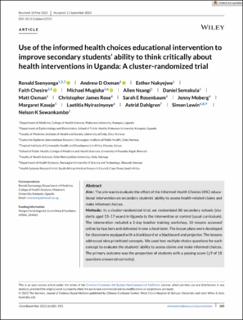Use of the informed health choices educational intervention to improve secondary students’ ability to think critically about health interventions in Uganda: A cluster-randomized trial
Ssenyonga, Ronald; Oxman, Andrew David; Nakyejwe, Esther; Chesire, Faith Chelagat; Mugisha, Michael; Nsangi, Allen; Semakula, Daniel; Oxman, Matt; Rose, Christopher James; Rosenbaum, Sarah Ellen; Moberg, Jenny Olivia Jenkins; Kaseje, Margaret; Nyirazinyoye, Laetitia; Dahlgren, Astrid; Lewin, Simon Arnold; Sewankambo, Nelson K
Peer reviewed, Journal article
Published version
Permanent lenke
https://hdl.handle.net/11250/3105319Utgivelsesdato
2023Metadata
Vis full innførselSamlinger
Originalversjon
Journal of Evidence-Based Medicine (JEBM). 2023, 16 (3), 259-413. 10.1111/jebm.12553Sammendrag
Aim:: The aim was to evaluate the effect of the Informed Health Choices (IHC) educa-
tional intervention on secondary students’ ability to assess health-related claims and
make informed choices.
Methods:: In a cluster-randomized trial, we randomized 80 secondary schools (stu-
dents aged 13–17 years) in Uganda to the intervention or control (usual curriculum).
The intervention included a 2-day teacher training workshop, 10 lessons accessed
online by teachers and delivered in one school term. The lesson plans were developed
for classrooms equipped with a blackboard or a blackboard and projector. The lessons
addressed nine prioritized concepts. We used two multiple-choice questions for each
concept to evaluate the students’ ability to assess claims and make informed choices.
The primary outcome was the proportion of students with a passing score (≥9 of 18
questions answered correctly).
Results:: Eighty schools consented and were randomly allocated. A total of 2477 stu-
dents in the 40 intervention schools and 2376 students in the 40 control schools
participated in this trial. In the intervention schools, 1364 (55%) of students that com-
pleted the test had a passing score compared with 586 (25%) of students in the control
schools (adjusted difference 33%, 95% CI 26%–39%).
Conclusions:: The IHC secondary school intervention improved students’ ability to
think critically and make informed choices. Well-designed digital resources may
improve access to educational material, even in schools without computers or other
information and communication technology (ICT). This could facilitate scaling-up
use of the resources and help to address inequities associated with limited ICT
access.

